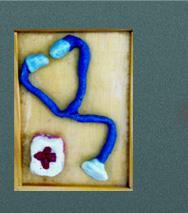
|
What is a hernia?
What is commonly called a hernia is actually an inguinal hernia. Here, when a child cries, there will be a swelling that appears in the groin, which may extend all the way down into the scrotum. When a child stops crying or straining, the swelling appears and feels perceptibly less tense. It may disappear altogether. It may even be possible to press gently on the hernia, and feel it pop back to where it came from.
It may happen that parents notice a hernia at home, but when a doctor examines the child, a hernia may not be evident. However, this does not mean that the hernia has been cured.
|
| |
 |
Why does the hernia appear?
A hernia is actually an extension of a fine sac, that is present inside the abdomen, and which contains the intestines and some fluid. In girls, the ovaries and fallopian tubes lie within this sac.
Before birth, the testicles lie within the abdomen, just behind this sac. They are stuck to the sac. These testicles ultimately descend down into the scrotum, and in doing so, pull a part of the sac down with them. In most situations, this extension closes down, but if it does not, then you have an open tract from the abdomen to the outside. So when there is straining, some fluid, or intestines, get pushed into this sac. When a child stops straining, the pressure from within eases up, and the hernia seems to disappear.
Though there are no testicles that descend in girls, there is a sac that sometimes persists along a similar tract. Therefore, hernias in girls are less common. When there is a hernia, besides the intestines or fluid, the ovaries may be forced into it. |
| |
 |
Does an undescended testis need treatment?
The scrotum has been created to give the best possible environment for the testis to grow, develop and function optimally. If the testis is not in the scrotum, there are issues with its development, and its ability to produce sperms. Also, testes which are not descended have an increased chance of developing cancers in early adult life. Moreover, there is a greater chance of undergoing a torsion. This means that the testis twists on its stalk. This can cut off its blood supply and can be very harmful to it. For these reasons testes which are not descended need surgery.
Retractile testes generally do not need surgery. Most correct spontaneously by the time the child attains puberty. Sometimes, retractility may cause growth retardation of the affected testicle. If so, the testis may need to be fixed in the scrotum.
|
| |
 |
Is there a need to treat a hernia? When should this be done? If the baby is too small, can this wait a bit?
When something goes down the hernia, it sometimes gets stuck into it. It then becomes difficult to “reduce” this hernia. This is a dangerous situation, and needs immediate treatment.
It is impossible to predict when this will happen. Therefore all hernias must be treated, to prevent such a situation from arising. Though hernias are not an emergency situation, once diagnosed, they should have surgery done early.
It is natural on the part of parents to want a very small baby to grow a bit before having surgery done . Unfortunately, the chances of having a hernia which is stuck, seem to be highest in the smallest babies. Handling such babies in an emergency situation is much more difficult than in a planned and controlled setting. Hence, hernia surgery should not be postponed, unless for medical reasons. It is better to plan such a surgery, and have it over and done with.
|
| |
|
 |
What operation is performed? Can it be done using a laparoscope?
During surgery, the extension of the sac is found in the groin, and tied off just as it emerges from within the abdomen. Laparoscopists do perform hernia surgeries, but there are no proven advantages over a simple hernia operation. In fact, the anaesthesia required is more extensive than in a simple hernia operation.
A hernia operation can be done as a day care procedure in most situations. |
| |
|
 |
What is a hydrocoele?
A hydrocoele is similar to a hernia, in that both develop similarly.
However the opening of a hydrocoele sac is so small, that only fluid, and no internal structures can enter the sac. This fluid enters and leaves the sac slowly, so there are no sudden changes in size. But parents will notice that a hydrocoele seems smallest when their child wakes up in the morning, and may seem most tense after a full day of activity in the evening. A hydrocoele is not painful, and cannot be pushed back, or emptied. |
| |
|
 |
Does a hydrocoele also need surgery, like a hernia?
Hydrocoeles are common in babies, but most resolve by themselves by the age of 2 years. This happens when the small opening closes spontaneously.
Also, since hydrocoeles contain only fluid, there is no question of anything getting stuck in them which can be dangerous. Hence hydrocoeles before the age of 2 years are observed. Most get resolved, and nothing needs to be done. If a hydrocoele does not disappear by then, it will need sugery.
Only occasionally, if the hydrocoele is very large and tense, surgery may be recommended before the age of two years.
|
|
A hydrocoele can be large, and needs surgery in an older child |
Hernias may often be subtle, and can appear as swellings in the groin |
|
|
|













